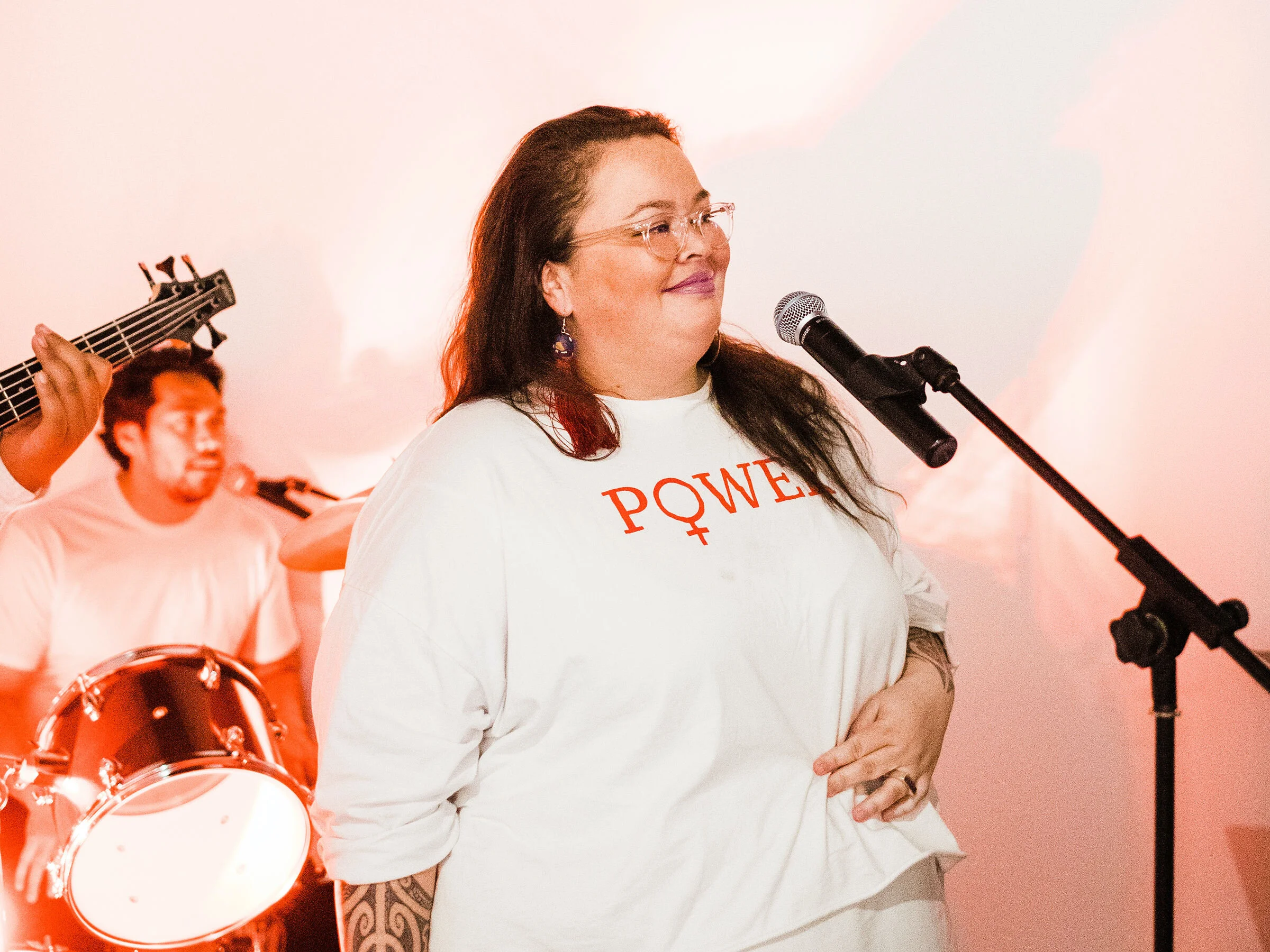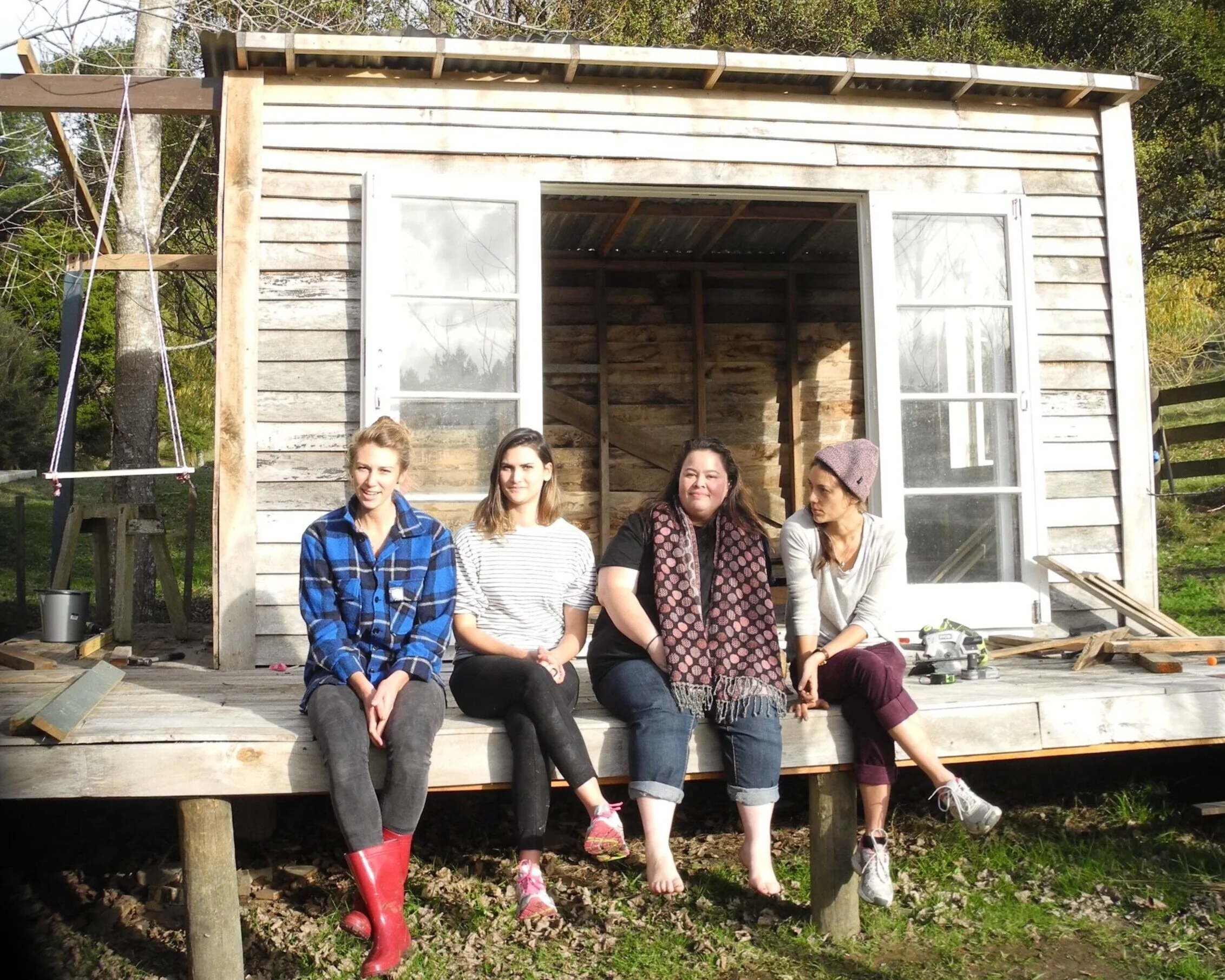Elisapeta Heta
designer, artist, indigenous advocate
Elisapeta Heta and band perform at a fundraiser at Objectspace, New Zealand. Photo: Jonny Scott
Interview by Janne Ryan | Photography by dean carruthers, Dennis Radermacher, ruby watson
Architecture was a dream for Elisapeta Heta. At night she’d draw the perfect family home, one that would solve all her family’s problems, pulling them out of poverty. Now she puts indigenous audiences at the centre of everything she does as a designer, and in her art practice. Elisapeta is Māori Design Leader and Senior Associate, with Jasmax, a New Zealand architecture studio.
Where do you live?
Well, that’s an interesting question, given the recent lockdown/pandemic. These days I feel like I live happily in the duality of two places: my head-home and my heart-home.
Head-home? What does this mean?
I have lived most of my life in Tāmaki Makaurau (Auckland) in Aotearoa New Zealand. I call it my head-home, because it’s been the place I’ve made home, and that has made me. It has stimulated my mind, my curiosity, my love of the urban landscape and my desire to improve it.
Nga Puna O Waiorea Western Springs College. The ‘Whare Tapere’ building by Jasmax is multipurpose, but mostly for kapa haka – Māori performing arts. It’s in the full immersion Māori part of the school. Photo: Dennis Radermacher
and Heart-home?
My heart-home – my spiritual one – is in the North. I grew up always going back, ‘up home’, to the North. During our country-wide lockdown, I have been living in a very small coastal community in Te Tai Tokerau (Northland) Aotearoa, called One Tree Point, with three generations of my whānau (family). I needed to be with my family, on healing lands.
“I thought the perfect home could fix everything.”
Why did you choose to study architecture?
I’ve wanted to do architecture since I was about five or six, although I didn’t know it was architecture then. Growing up in a house that wasn’t big enough to fit our family, in various states of poverty, left me wanting more for myself. In bed at night I used to draw my family’s dream home. I thought the perfect home could fix everything.
Where did you live as a young girl?
The ‘Whare Ako’ or learning building by Jasmax, in the full immersion Māori part of Nga Puna O Waiorea Western Springs College. Photo: Dennis Radermacher
My life began in the small Tāmaki Makaurau / Auckland suburb of Ranui, in a tiny (seriously tiny!) railway cottage designed as temporary accommodation for a single man working the railway, not a family of five. We also lived in an ex-state (public housing) house. None of these houses was insulated, all of them flowing with family* and friends often staying for extended periods.
* Elisapeta’s mother was born in Takapuna in the 1960s, a first-generation New Zealander; her father was born in Portsmith, England; her grandmother was born in Apia, Sāmoa.
What was the turning point?
Our great-grandmother – who helped us purchase our second home – used to buy us those Australian ‘lottery’ brochures. You could win an insanely large house on the Gold Coast… but the thing that interested me was the brochure always had a floor plan on it. And a teacher taught me how to draw… I guess I haven’t turned back.
I knew very early on that there weren’t many who would look like me.
What did studying architecture teach you?
Architecture is an overlapping pursuit of beauty and practicality, of joy and necessity. It expresses both the culture of a people and the intimacy of day-to-day survival. It connects us to something beyond ourselves.
On being a Māori woman studying architecture?
I knew very early on (as a teenager) that there weren’t many who would look like me, who would come from where I came from, who studied / practiced architecture. My stubbornness drives me. I’m very curious. I love to learn. Education has always been an escape and a saviour… and a passion. I’m somewhat convinced now, that passion and inquisitiveness are super-powers.
“Passion & inquisitiveness are super-powers.”
What drives you each day?
Fixing things for others, I want to be helpful, of service. I think that’s a heavy influence from my mother and what I saw as the inevitable obligations woven into her Sāmoan culture: that we are to serve our families, our community, our peoples. I want to provide for myself, my family and any future family I have in a way my parents weren’t able to.
Also, I’ve always wanted to work for and with my people – Māori and Pasifika, specifically. As I’ve grown into my job, this has really underscored much of what I do: to whakamana (empower, uplift) the Mana of Māori but also indigenous peoples as far and wide as I am able. I’ve never been short of an ambition or two.
“The settler colonial-west is just waking up to the sound of indigenous peoples knocking at their doors.”
Why did you become an artist?
For me art and architecture aren’t opposing forces, although the challenge with architecture is its tie to all things commercial - a client and a budget. Art allows me to test ideas, to unearth narratives, to provoke and sit with, or draw upon, difficult emotions and conversations. I often think about art as stitching together parts of time, of responding to the kaupapa (purpose).*
* Elisapeta’s collaboration with Māori photographer John Miller is part of NIRIN, 2020 Sydney Biennale. Their work is currently on display at Sydney’s Campbelltown Art Gallery.
Founders of the 2013 The Whare in the Bush project (from left): Ruby Watson, Rebecca Green, Elisapeta Heta, Raukura Turei. The project to build this 10 square-metre whare (house) sparked a subsequent exhibition and publication, Gentle Foundations.
common ground in practicing design and art?
I put indigenous audiences at the centre of everything I do. To centre the indigenous experience has become a huge influence in all the worlds I walk in. The settler colonial-west are only just beginning to wake up to the sound of indigenous peoples knocking at their doors. And I’m here for it.
Game-changer moments?
Learning to trust my intuition – or follow the mauri (life force), and mana (power, strength) – and my voice. This has never led me astray, in spite of being scared as hell, but doing it anyway. The notion that our tūpuna (ancestors) are always with us has been a gentle hand, allowing me to settle into the ‘flow’ of projects. Survivor resilience is a strong space to stand within.
“I put indigenous audiences at the centre of everything I do. ”
Achieving goals: what does this mean to you?
I have many, many goals, and they’re not simple ones either. Practically, I’m actually not a ‘registered’ architect, so a short-term (next 12 months) goal is working towards registration. I get lots of support around that, it’s more mechanics, but it’s by no means easy. Long term my goals are more lofty, and I’m almost nervous to say them publicly, but here goes. I’d really love to continue finding ways to bring my art and architecture lives together. More collaborations with other artists, more exhibition design / spatial work, but also working towards more art / architecture work of my own.
“Opportunities feel like spontaneous circumstances you planned hard to be ready for.”
Not unrelated, because the two are basically on the same wavelength, but I’d like to continue travelling and supporting better built environment outcomes for indigenous peoples in our urban contexts. There are a lot of gains to be shared with the international indigenous design community. I did a short residency in Toronto, Canada, last year and it was the most creatively juicy, and physically restful experience. Opportunities feel like spontaneous circumstances you planned hard to be ready for.
The Pouwatu: Active Presence exhibition by Elisapeta Heta and photographer John Miller, in Campbelltown Arts Centre for NIRIN, in the 2020 Biennale of Sydney.
Where to from here?
Hopefully, we are able to bring the show from NIRIN home to Aotearoa at Objectspace Gallery, this year. Lots of the gallery schedules are obviously quite up in the air, but this show Pouwātū: Active Presence, needs to come home. John Miller has been so diligently documenting Māori life, and Aotearoa, for so long, it deserves a celebration – and hopefully not one at a physical distance. My future, well, if it aligns to the greater purpose of my desire to whakamana our people, through our built environment, through our story telling, through our art, then I’m sure I’m heading somewhat in the right direction.
Elisapeta Heta’s ‘e hine, e’ poster for the 2019 NZ national travelling poster project, Present Tense: Wahine Toi Aotearoa, by Designers Speak Up Collective.








